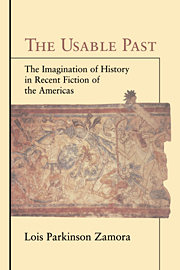PART I - ANXIETY OF ORIGINS
Published online by Cambridge University Press: 01 September 2009
Summary
If Death and Liberty
Can be personified,
Why not History?
It's got to be a fat old man
In faded overalls
Outside a house trailer
On a muddy road to some place called Pittsfield or Babylon.
He draws the magic circle
So the chickens can't get out,
Then he hobbles to the kitchen
For the knife and pail.
Today he's back carrying
A sack of yellow corn.
You can hear the hens cluck,
The young cocks strut their stuff.
Charles Simic, “Severe Figures”THAT FAT OLD MAN in faded overalls is well suited to introduce this study of the historical imagination in U.S. and Latin American fiction. History has indeed been one of the severest figures of the America's collective imagination. The barnyard fairly reeks of that familiar historical anxiety, the motivation and theme of so much of our fiction. There he goes now, clutching his instruments, terrorizing those dumb clucks whose collective fate he seals. Then again, he's fickle, so tomorrow we may get corn. But what's this? History hobbles? Or is he hobbled by the writers who created him? After all, they too travel along that apocalyptic road to Pittsfield, Babylon. We might easily mistake Charles Simic's old man for the eighth deadly sin in some medieval morality play, ready to take the stage with the likes of gluttony and lust and avarice. But no. He is, in fact, the first deadly sin of the novel.
- Type
- Chapter
- Information
- The Usable PastThe Imagination of History in Recent Fiction of the Americas, pp. 1 - 14Publisher: Cambridge University PressPrint publication year: 1997



